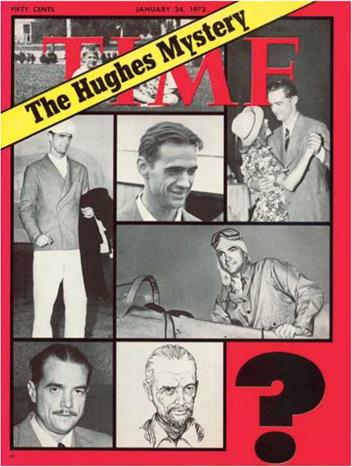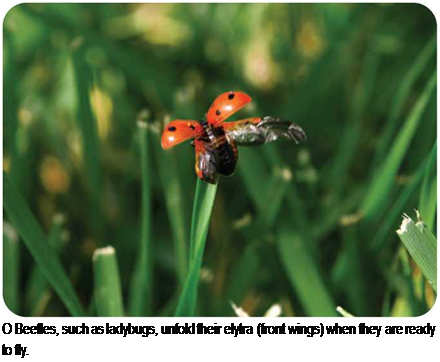From Manufacturing to Airlines
In spite of these failures, Hughes turned his manufacturing company into a leading force in the aviation field after World War II. One division made helicopters. Another eventually made satellites. Over the years, the company produced more than one-third of all the satellites being used by businesses. Eventually, the company was broken up, and its divisions were sold to other corporations.
 Од 1972 issue of Time magazine featured the reclusive Howard Hughes on its cover. There were rumors that his mind and appearance deteriorated in his later years, but there were no photographs of him.
Од 1972 issue of Time magazine featured the reclusive Howard Hughes on its cover. There were rumors that his mind and appearance deteriorated in his later years, but there were no photographs of him.
Hughes also became involved in the airline industry. In 1939, he bought the majority of TransWorld Airlines (TWA), which he hoped to build into the world’s leading airline. As part of that effort, he made an agreement with Lockheed to build a new passenger plane. The result-the Constellation-was an innovative new plane.
Hughes’s effort to build the airline clashed with the ambitions of Juan Trippe, the head of Pan American World Airways.
Senator Owen Brewster of Maine, an ally of Trippe’s, called Hughes to testify before a Senate committee. Under harsh criticism, Hughes counterattacked by revealing the senator’s connections with Pan Am. Hughes was never charged with any wrongdoing. He later funded the victorious campaign of the man who defeated Brewster in his bid for reelection.
Hughes’s troubles with the government did not end, however. Federal officials informed him it was a conflict of interest for him to own both TWA and an aircraft manufacturing company. Eventually, Hughes had to sell his interest in TWA.
Always shy and eccentric, Hughes lived as a recluse from the 1960s on. Obsessed with living in a completely germ-free environment, he ate almost no food, and took many drugs. These actions destroyed his health. He died in 1976-a lonely, often ridiculed, and vastly wealthy old man.
N
SEE ALSO:
• Aerospace Manufacturing
Industry • Aircraft Design
• Aircraft, Experimental • Satellite
• Flying Boat and Seaplane
_____________________________________________ /
![]()


 |
Insects are among the animals on Earth which have wings (the others are bats and birds). About 400 million years ago, the first animals to fly included insects. There are about 1 million species of insects—three times as many as all the other animal species in the world. The most common features of insects are their small size, their crawling motion, and their ability to fly.
Wings and Other Parts
Insects have small, light bodies. The body of an adult insect has three parts: the head, the thorax, and the abdomen. The thorax is the “engine room” of the animal. An insect’s wings are attached to the middle and rear segments of the thorax. The wings are worked by two sets of powerful muscles, which make the wings beat up and down and also twist. Muscles attached to the base of each wing control the direction of flight, allowing an insect to change direction, fly backward and forward, or hover in midair like a helicopter.
Flies have two wings, fixed to the center body section or thorax. Other insects have four wings in two pairs. Examples of four-winged insects are butterflies, moths, dragonflies, bees, and wasps. In a four-winged insect, the two wings on one side of the body often beat together as if they were one wing. In some insects, the wings overlap slightly, while in others the wings are locked together by a system of hooks or hairs.
Many insects have wings in their adult state, although many flying insects (dragonflies, for example) are flightless as juveniles. The wings of a young insect start to grow as tiny pads, visible only through a microscope, or sometimes (as in caterpillars), they are inside the body.
 When the young insect molts (sheds its skin as it grows larger), the wing pads grow. After the last molt, the pads become fully formed wings. This change, or metamorphosis, is seen to startling effect in moths and butterflies.
When the young insect molts (sheds its skin as it grows larger), the wing pads grow. After the last molt, the pads become fully formed wings. This change, or metamorphosis, is seen to startling effect in moths and butterflies.
The adult emerges from the chrysalis with its wings damp and still folded. As the wings dry and are stiffened by blood flowing through the veins inside them, they unfold and often reveal brilliant colors.
In beetles, the front wings have become hard covers called elytra. The elytra are folded over the rear wings, until the beetle starts to fly. Then they swing outward, like airplane wings. The rear wings do the actual flying.
Other insects have no wings at all or only weak vestiges (remains) of wings that are no use for flying. Most ants, for example, are wingless. Only males and female queens have wings, which are used to fly from the nest during their mating flight. The males die after mating, and the queens spend the rest of their lives underground.










